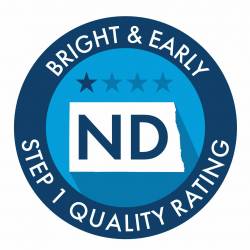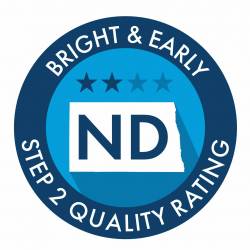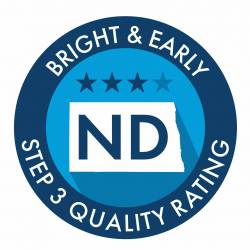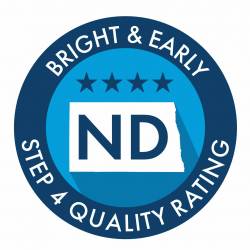Choosing the right type of care for your child requires an investment of time. Use the online search tool, checklist and other resources to help you make an informed decision.
Learn About Your Options
When looking for an early childhood program, there are several types to choose from. You will want to take your family’s needs, preferences, and experiences into account and choose the type of care that is the best fit for you.
Begin Your Search
Begin your search for early childhood programs by using the free online search tool. Get customized results by adjusting criteria like location, hours of operation, and ages served. Personalized help is available through your local Child Care Resource and Referral by calling 1-800-997-8515 or by emailing referral@ndchildcare.org.
Visit and Ask Questions
Visit programs in-person and talk with the providers. Use the Child Care Checklist as a guide to the most important things to look for and key questions to ask.
Take a Closer Look
Check references and records for the programs you are considering. Ask for references from families who are currently using the program and families who have used the program in the past. When using the free online search tool, make sure to look over the program's licensing status, inspection reports, and Bright & Early ND Quality Rating.
Licensing Status
Check to see if the program is licensed, registered, certified, or legally licensed-exempt. Also, see if the program’s license been suspended or revoked.
Inspection Reports
Look at each program’s inspection reports to see if the program has violated any health and safety requirements and if and how they fixed those violations. You can also see if there was a complaint filed against the program that was found to be valid.
Bright & Early ND Quality Rating
Bright & Early ND is North Dakota's Quality Rating and Improvement System (QRIS) designed to assess, improve, and communicate the level of quality of early childhood programs. We help families identify high-quality early childhood programs that build the foundation children need to thrive in school and in life.
Bright & Early ND uses a set of clear, research-informed criteria to measure and support quality in early childhood programs. These standards go beyond rating—they help programs reflect on their current practices, set meaningful goals, and grow over time. While not exhaustive, the standards provide a shared framework for recognizing, supporting, and strengthening quality across North Dakota.
Early childhood programs can voluntarily progress through four levels, or steps, of quality. Each step builds upon the previous one, and programs must fully meet the criteria of each step before advancing. This step-by-step approach supports meaningful quality improvement at a pace that works for each program.
Bright & Early ND Quality Ratings are reliable and easy to understand. Look for the Bright & Early ND Quality Rating badge to spot an early childhood program that is going above and beyond for the children in their care.
Step 1: Health and Safety

A healthy and safe environment is the foundation of high-quality early childhood experiences. When children are healthy and feel safe, they are better able to explore, build relationships, and engage in meaningful learning.
Programs that meet this standard:
- Are licensed by Health and Human Services and meet basic requirements for space, safety, cleanliness, staff qualifications, and staff-to-child ratios.
- Receive regular monitoring visits from a Licensing Specialist who ensure that licensing regulations are being followed through on-site visits, record reviews, and observations.
- Promote physical safety by actively preventing injuries, while also supporting safe, age-appropriate risk-taking that encourages exploration and development.
All licensed early childhood programs in North Dakota are automatically enrolled in Bright & Early ND with a Step 1 Quality Rating.
Step 2: Space and Materials

Building on a foundation of health and safety, Step 2 focuses on creating environments that inspire hands-on exploration, reflect children’s interests, and promote independence. When children are in intentionally designed environments, they are more likely to engage deeply, think critically, and develop a strong sense of self.
Programs that meet this standard:
- Continue to meet the requirements of Step 1.
- Design indoor and outdoor environments that are organized, welcoming, and offer a variety of age-appropriate materials that support learning through exploration.
- Use children's interests and developmental stages to guide the selection and rotation of materials, creating spaces that promote engagement, creativity, and social interaction.
- Regularly reflect on and adjust the environment to ensure inclusivity and support for each child’s development and learning.
Step 3: Activities and Experiences

Building on safe, supportive environments, Step 3 emphasizes intentional, meaningful activities that build on each child's strengths and developmental progress. When learning experiences are planned with purpose and aligned with developmental goals, children are more likely to thrive—academically, socially, and emotionally.
Programs that meet this standard:
- Continue to meet the requirements of Step 1 and Step 2.
- Use a curriculum aligned with the North Dakota Early Learning Standards: Birth to Kindergarten to plan activities and guide teaching practices.
- Conduct observation-based assessments to ensure children are making progress toward developmental milestones and goals.
Step 4: Relationships and Interactions

At the highest level of quality, programs cultivate warm, supportive environments where they feel safe to take risks, explore new ideas, and build strong relationships. Positive, responsive interactions between children and caregivers lay the foundation for lifelong learning, social development, and emotional well-being.
Programs that meet this standard:
- Continue to meet the requirements of Steps 1-3.
- Build caring, respectful relationships with each child and encourage positive connections among children.
- Consider children’s interests, motivations, and perspectives in daily routines and activities.
- Support children’s thinking and language development through thoughtful, engaging conversations.
Get Involved!
Now that your child is enrolled, what’s next? You are your child’s first and most important teacher! Play, read, sing and talk with your child every day. Make sure you talk to your child’s provider regularly about how your child is doing at home and in child care.
